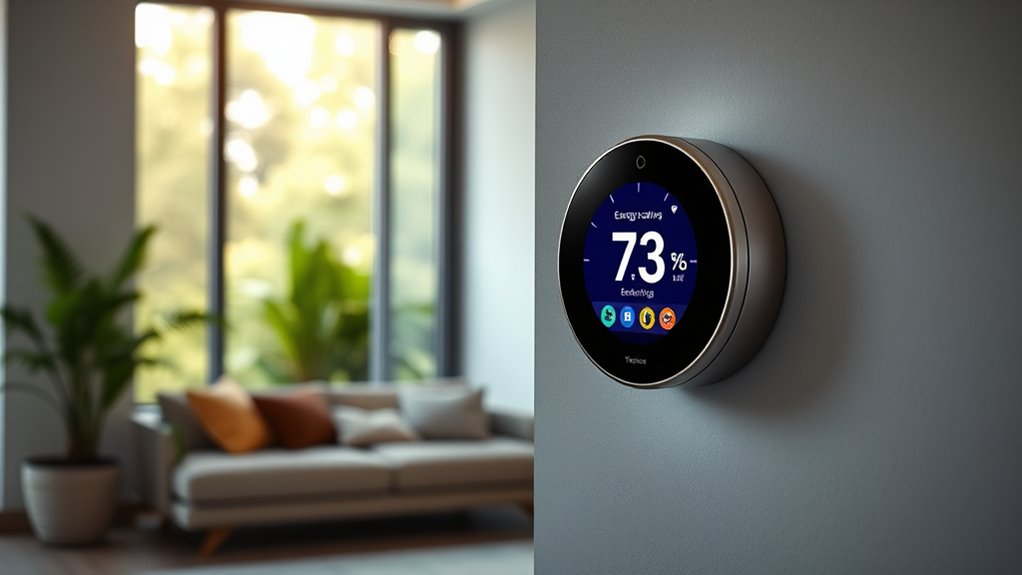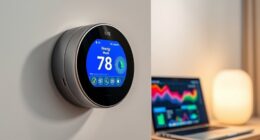If you’re looking to boost your savings with energy-efficient smart thermostats, I recommend options like the Nest Learning Thermostat, ecobee smart models, and Sensi Touch, which combine automation with gamification features that motivate you to cut energy use. These devices support multiple smart home integrations, offer remote control, and often include sensors and customizable schedules to keep your home comfortable and efficient. Keep exploring to discover which thermostat fits your needs best.
Key Takeaways
- Many smart thermostats include energy reports, gamification features, and rewards to motivate users to save more energy.
- Models like ecobee and Sensi offer customizable schedules and real-time feedback that encourage energy-efficient habits.
- Compatibility with smart home ecosystems enables automation and reward-based challenges to optimize energy usage.
- User engagement is enhanced through features like detailed energy savings stats, smart mode challenges, and interactive apps.
- Certain thermostats integrate with third-party apps and platforms that promote gamification for increased energy conservation.
Google Nest Learning Thermostat (4th Gen, 2024) with Nest Temperature Sensor

If you’re looking for a smart thermostat that combines advanced learning capabilities with effortless energy savings, the Google Nest Learning Thermostat (4th Gen, 2024) with Nest Temperature Sensor is an excellent choice. It works with most 24V systems, often requiring no C wire, and is Matter compatible for seamless smart home integration. The sleek design features a larger display with Dynamic Farsight, making information easy to see from across the room. It learns your habits, adjusts schedules automatically, and supports remote control via the Google Home app or voice commands. With the included Nest Temperature Sensor, you can manage hot and cold spots for maximum comfort and efficiency.
Best For: homeowners seeking an intelligent, energy-efficient smart thermostat that easily integrates with existing systems and offers personalized comfort.
Pros:
- Advanced self-learning technology that automatically adjusts heating and cooling schedules for optimal energy savings
- Large, attractive display with Dynamic Farsight for easy visibility from across the room
- Seamless compatibility with most 24V systems and Matter-enabled smart home devices, controllable via app or voice commands
Cons:
- May require professional installation if specific system compatibility issues arise
- Some users might find the extensive features and settings complex to navigate initially
- Higher price point compared to basic thermostats due to advanced features and sensors
ecobee Smart Thermostat Enhanced with Wi-Fi and Voice Assistant Compatibility
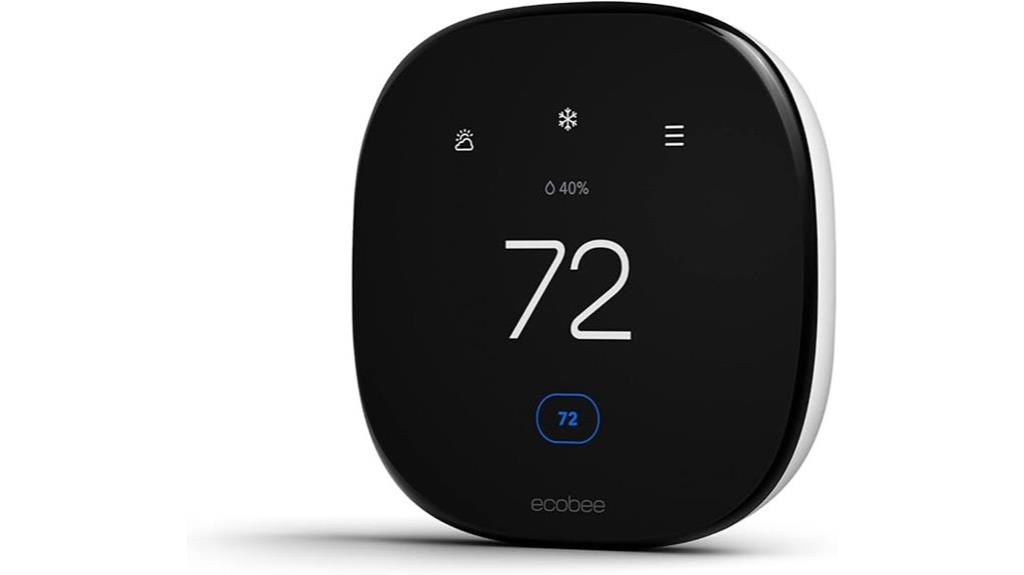
The ecobee Smart Thermostat Enhanced stands out for homeowners who want seamless smart home integration and voice control. It helps save up to 26% annually on heating and cooling by automatically adjusting temperatures when you’re away and preheating or precooling before arrival. The thermostat also manages humidity for consistent comfort and uses SmartSensor to focus on key rooms. Compatible with Siri, Alexa, Google Assistant, and most platforms, you can control it remotely via the ecobee app or through voice commands. Easy to install with a Power Extender Kit, it suits most HVAC systems and is Energy Star certified, combining convenience with energy efficiency.
Best For: homeowners seeking seamless smart home integration, voice control, and energy savings for their HVAC systems.
Pros:
- Saves up to 26% annually on heating and cooling costs.
- Compatible with multiple voice assistants and smart home platforms for easy control.
- Easy to install with a Power Extender Kit and suitable for most HVAC systems.
Cons:
- Requires Wi-Fi connection for full functionality, which may be a limitation in areas with poor connectivity.
- Some advanced features may require familiarity with smart home setups and app management.
- The need for optional SmartSensor for room-specific control may involve additional cost.
meross Smart Thermostat for Home with WiFi and Voice Control

The meross Smart Thermostat is an excellent choice for homeowners seeking easy installation and broad HVAC compatibility. It supports 95% of systems, including conventional heating and cooling, heat pumps, and heating-only or cooling-only setups. You’ll need a C-wire for proper operation, or you can use the Meross adapter if you don’t have one. Installation is simple and quick, often completed within 30 minutes through the app. It offers remote control via Wi-Fi, allowing you to adjust temperatures from anywhere. With Matter support, it integrates seamlessly with major smart home platforms like Alexa, Google, and Apple, enhancing convenience and automation.
Best For: homeowners seeking a versatile, easy-to-install smart thermostat compatible with most HVAC systems and smart home platforms.
Pros:
- Supports 95% of HVAC systems, including heat pumps and conventional setups
- Easy 30-minute installation with app setup wizard
- Integrates seamlessly with major smart home platforms via Matter, supporting voice control
Cons:
- Requires a C-wire for proper operation or the use of a Meross adapter
- Only compatible with 2.4GHz Wi-Fi networks, limiting connectivity options
- Not compatible with electric baseboard heaters
Sensi Touch 2 Smart Thermostat with Touchscreen
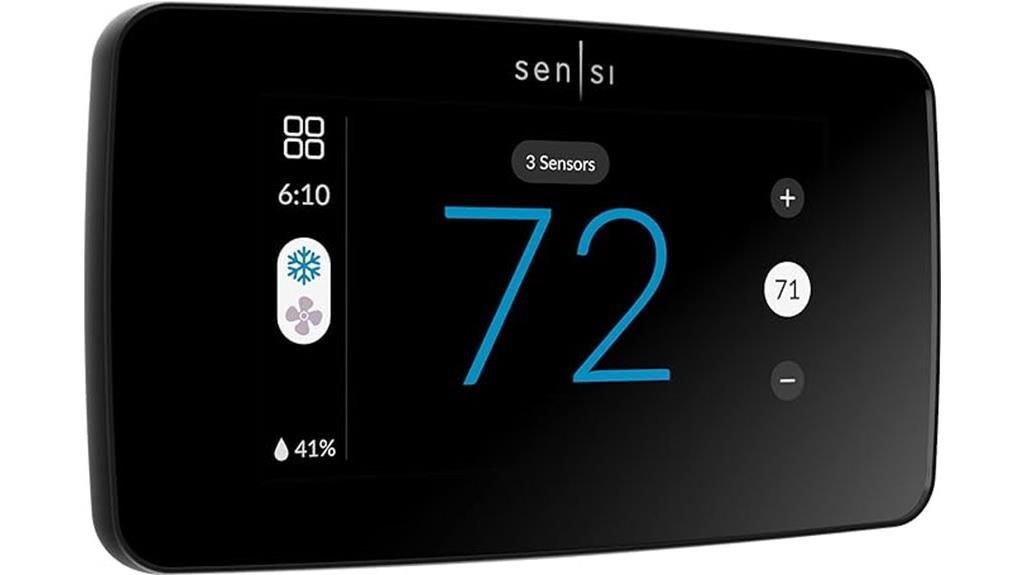
For homeowners seeking an easy-to-use, energy-efficient thermostat, the Sensi Touch 2 Smart Thermostat with Touchscreen stands out with its sleek LCD display and intuitive app. It offers programmable scheduling, Wi-Fi connectivity, and voice control through Alexa, Google Assistant, and Samsung SmartThings. ENERGY STAR certified and Title 24 compliant, it’s designed for DIY installation with clear setup guidance. Compatible with most HVAC systems, including boilers, heat pumps, and furnaces, it supports room sensors to optimize comfort and efficiency. With features that help save around 23% on energy costs, it’s a smart choice for improving home comfort while reducing bills.
Best For: homeowners seeking an easy-to-install, energy-efficient smart thermostat with modern design and voice control capabilities.
Pros:
- Sleek LCD touchscreen display with intuitive app for simple control and scheduling
- Supports room sensors for balanced comfort and increased energy savings
- Compatible with popular voice assistants like Alexa, Google Assistant, and Samsung SmartThings
Cons:
- Limited temperature adjustment ranges for auxiliary heat or very low-temperature settings
- Some users experience difficulty accessing outside temperature data on the device
- Variability in technical support responsiveness and potential hardware reliability concerns
Google Nest Learning Thermostat (4th Gen, 2024) with Nest Temperature Sensor
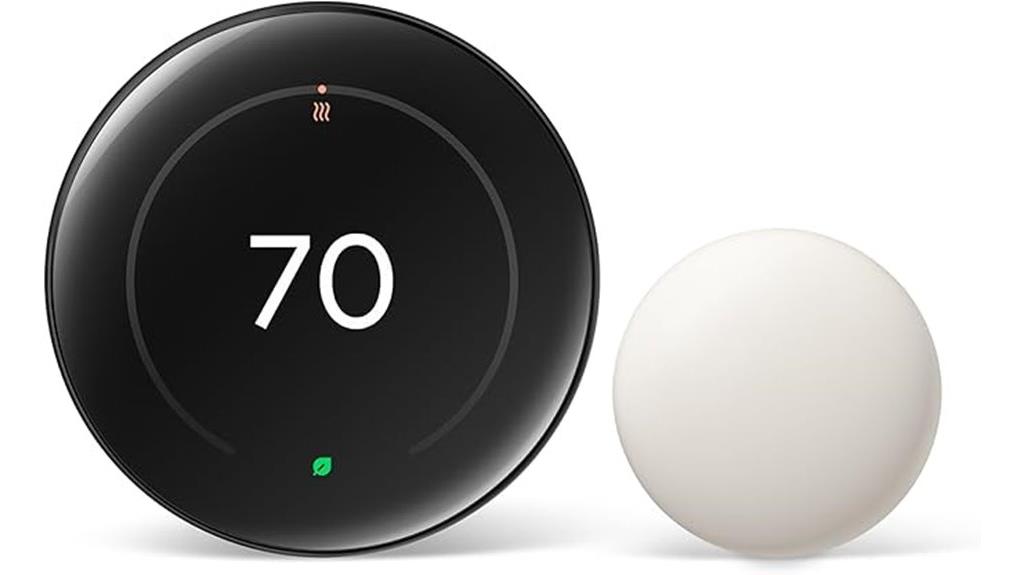
If you’re looking to maximize energy savings and home comfort, the Google Nest Learning Thermostat (4th Gen, 2024) with Nest Temperature Sensor is an excellent choice. Its sleek Obsidian finish and larger display with Dynamic Farsight make it both stylish and easy to read from across the room. It integrates seamlessly with smart home ecosystems like Alexa, Apple HomeKit, and Google Assistant. The thermostat learns your habits to optimize heating and cooling, saving you around 12% on heating bills and 15% on cooling. Plus, with compatible sensors in different rooms, it manages hot and cold spots for consistent comfort and energy efficiency.
Best For: homeowners seeking to enhance energy efficiency and home comfort with a sleek, smart thermostat that integrates seamlessly into various smart home ecosystems.
Pros:
- Large, clear display with Dynamic Farsight for easy readability from across the room
- Compatible with popular smart assistants like Alexa, Google Assistant, and Apple HomeKit
- Learns user habits to optimize heating and cooling, leading to significant energy savings
Cons:
- May require professional installation for optimal setup in some systems
- Relies on Wi-Fi connectivity for remote control and updates, which could be an issue in unstable networks
- Additional Nest Temperature Sensors are sold separately, increasing overall cost for multi-room management
Amazon Smart Thermostat
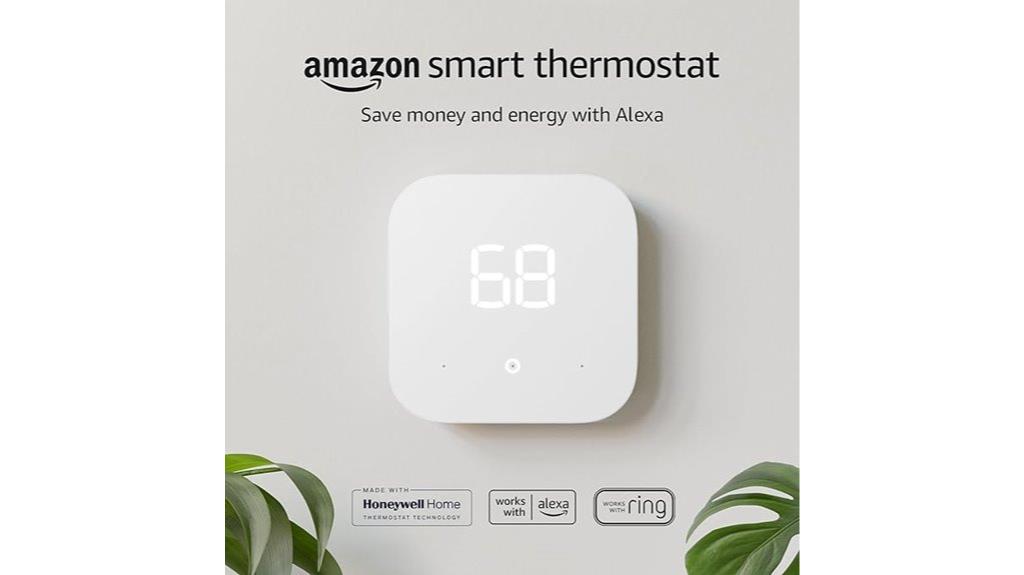
Anyone looking for a seamless, smart home upgrade will appreciate the Amazon Smart Thermostat’s easy installation and compatibility with existing C-wire systems. It integrates effortlessly with Alexa and Ring devices, allowing voice control and smart home automation. You can use compatible Echo devices, like the Echo Dot (4th and 5th gen), to manage your temperature settings easily. The thermostat supports remote adjustments via the Alexa app, helping you save energy and reduce costs—EPA estimates suggest about $50 annually. Amazon also offers guided setup and customer support, ensuring a smooth experience. Built with trusted Honeywell technology, it’s a reliable, efficient choice for smarter, energy-conscious living.
Best For: smart homeowners seeking an easy-to-install, energy-efficient thermostat that integrates seamlessly with Alexa and Ring devices for voice control and automation.
Pros:
- Easy installation with guided setup and compatibility with existing C-wire systems
- Supports remote control via the Alexa app for convenient temperature management from anywhere
- Helps reduce energy consumption and costs, with EPA estimates of approximately $50 annual savings
Cons:
- Limited compatibility with non-Alexa or Ring smart home ecosystems
- Requires a C-wire for installation, which may not be present in all homes
- Advanced features depend on stable Wi-Fi and smartphone app connectivity
Sensi Lite Smart Thermostat
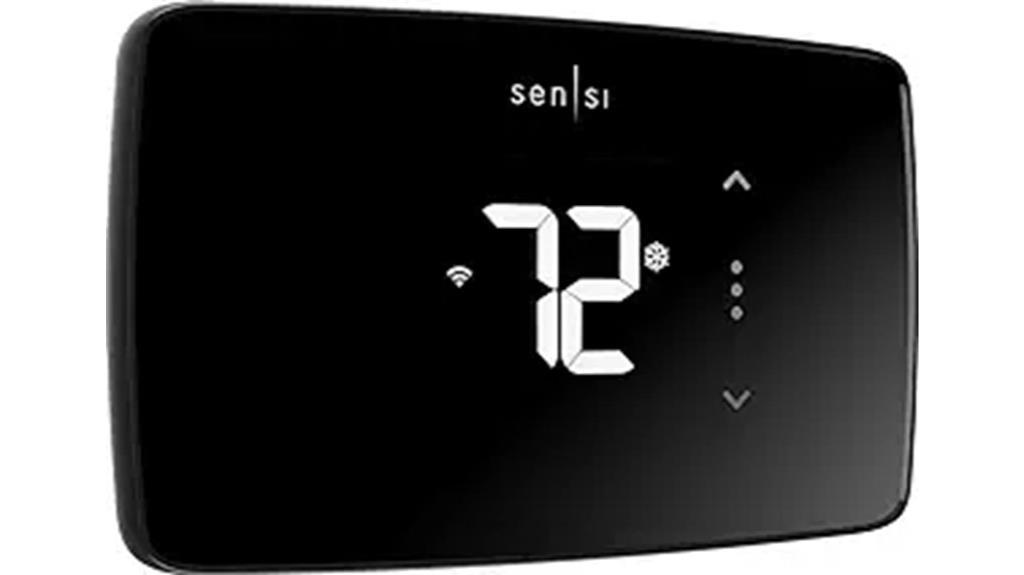
The Sensi Lite Smart Thermostat stands out as an excellent choice for homeowners seeking a straightforward, energy-efficient control system that’s easy to install and use. It’s Energy Star certified, supporting Wi-Fi app control, Alexa, Google Assistant, and SmartThings. With a compact design, LCD display, and simple style, it fits most HVAC systems, often without needing a C-wire. Features like programmable schedules, auto changeover, and a filter indicator help optimize energy use. Setup is simple, with step-by-step instructions and QR code scanning. While some wiring considerations apply, especially for heat pumps, its user-friendly interface and energy-saving capabilities make it an appealing option for those wanting reliable smart control.
Best For: homeowners seeking an easy-to-install, energy-efficient smart thermostat with basic scheduling and remote control features that fits most HVAC systems without requiring extensive wiring.
Pros:
- Easy DIY installation with clear instructions and QR code setup
- Compatible with various smart home platforms like Alexa, Google Assistant, and SmartThings
- Energy Star certified, offering approximately 23% HVAC energy savings
Cons:
- Connectivity issues may occur after power outages or battery changes, requiring troubleshooting
- Limited scheduling flexibility and app statistics compared to higher-end models
- Not recommended for use outside the US and Canada, with some wiring considerations for heat pump systems
meross Smart Thermostat with WiFi and Voice Control
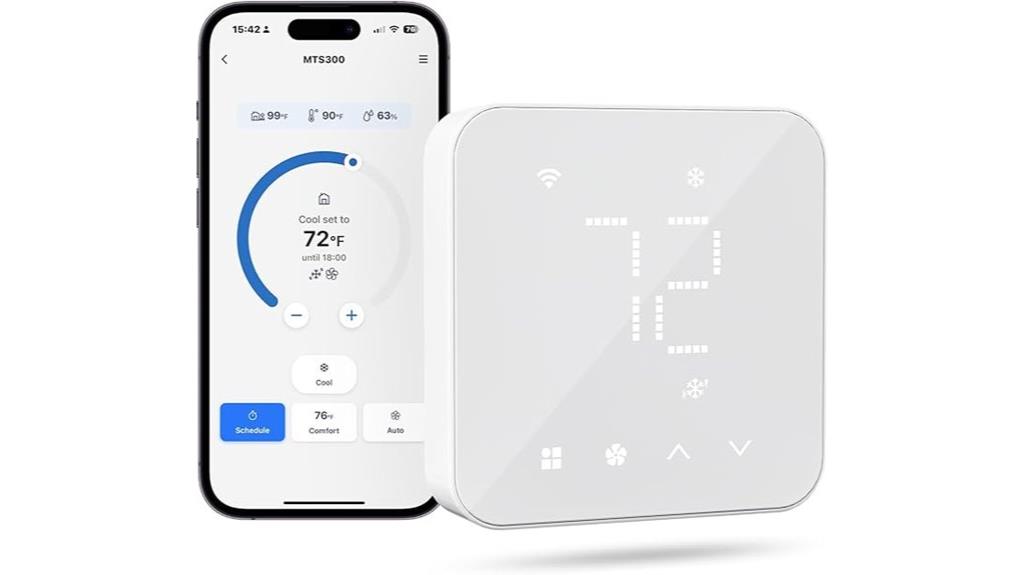
The meross Smart Thermostat with WiFi and Voice Control stands out for its broad compatibility with most HVAC systems, making it an ideal choice for homeowners seeking a versatile and easy-to-install solution. It supports 95% of HVAC setups, including conventional heating, cooling, heat pumps, and heating-only systems, though it’s not compatible with electric baseboard heaters. It requires a C-wire for proper operation, or you can use the Meross C-wire adapter if needed. Supporting only 2.4GHz Wi-Fi, it offers customizable 7×24-hour scheduling and can operate offline, maintaining routines without Wi-Fi. Plus, it integrates seamlessly with popular voice platforms like Alexa, Google, and Apple.
Best For: homeowners seeking a versatile, easy-to-install smart thermostat compatible with most HVAC systems and voice platforms.
Pros:
- Broad compatibility with 95% of HVAC systems, including conventional heating, cooling, and heat pumps
- Supports customizable 7×24-hour scheduling with offline operation, ensuring consistent comfort
- Seamless integration with Apple Home, Amazon Alexa, Google Home, and Samsung SmartThings via Matter technology
Cons:
- Not compatible with electric baseboard heaters
- Requires a C-wire for installation, which may necessitate an adapter if not available
- Limited to 2.4GHz Wi-Fi networks, potentially reducing compatibility with newer or dual-band routers
ecobee Smart Thermostat Enhanced
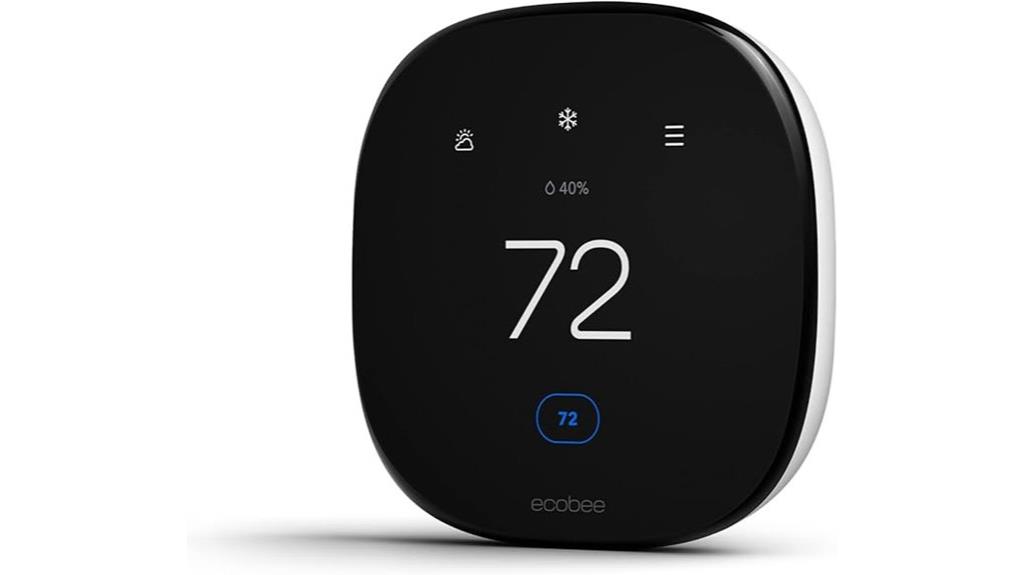
If you want a smart thermostat that combines energy savings with personalized comfort, the ecobee Smart Thermostat Enhanced is an excellent choice. It can save up to 26% annually on heating and cooling costs by automatically adjusting temperatures when you’re away and preheating or precooling your home before you arrive. It also monitors humidity to keep your environment comfortable. With SmartSensor technology, it focuses on key rooms to optimize performance. Compatible with major smart home platforms like Siri, Alexa, and Google Assistant, you can control it remotely via the ecobee app or voice commands. Easy to install and Energy Star Certified, it’s a reliable, efficient upgrade.
Best For: homeowners seeking an energy-efficient, smart, and user-friendly thermostat that integrates seamlessly with popular voice assistants and smart home platforms.
Pros:
- Saves up to 26% annually on heating and cooling costs through automated adjustments and humidity control.
- Compatible with most HVAC systems and major smart home platforms like Siri, Alexa, and Google Assistant for convenient control.
- Easy to install with features like Power Extender Kit and Energy Star certification for reliable, energy-efficient operation.
Cons:
- May require professional installation for optimal setup, especially if C-Wire is needed.
- Limited to 24 VAC HVAC systems, possibly excluding some older or specialized systems.
- Some advanced features, like SmartSensor setup, may involve a learning curve for new users.
Sensi Smart Thermostat

Are you looking for a smart thermostat that’s easy to install and offers reliable energy savings? The Sensi Smart Thermostat (model ST55) fits the bill with its DIY-friendly design, Wi-Fi connectivity, and voice control compatibility with Alexa, Google Assistant, SmartThings, and Vera. Its sleek LED display, backlight, and button controls make manual adjustments simple. It’s compatible with most HVAC systems, often without needing a C-wire. Plus, it helps save around 23% on energy bills through scheduling, remote access, and detailed reports. Easy to set up, it’s perfect for homeowners seeking a reliable, user-friendly way to boost energy efficiency.
Best For: homeowners seeking an easy-to-install, energy-efficient smart thermostat compatible with popular voice assistants and HVAC systems.
Pros:
- DIY-friendly installation with step-by-step app guidance and built-in level
- Energy Star certified, helping save approximately 23% on HVAC energy bills
- Compatible with Alexa, Google Assistant, SmartThings, and Vera for voice control
Cons:
- Limited support for Bixby voice assistant
- Some users report occasional connectivity or setting adjustment issues
- May offer limited detailed usage data compared to higher-end models
Inkbird ITC-308 Digital Temperature Controller (110V, 10A)
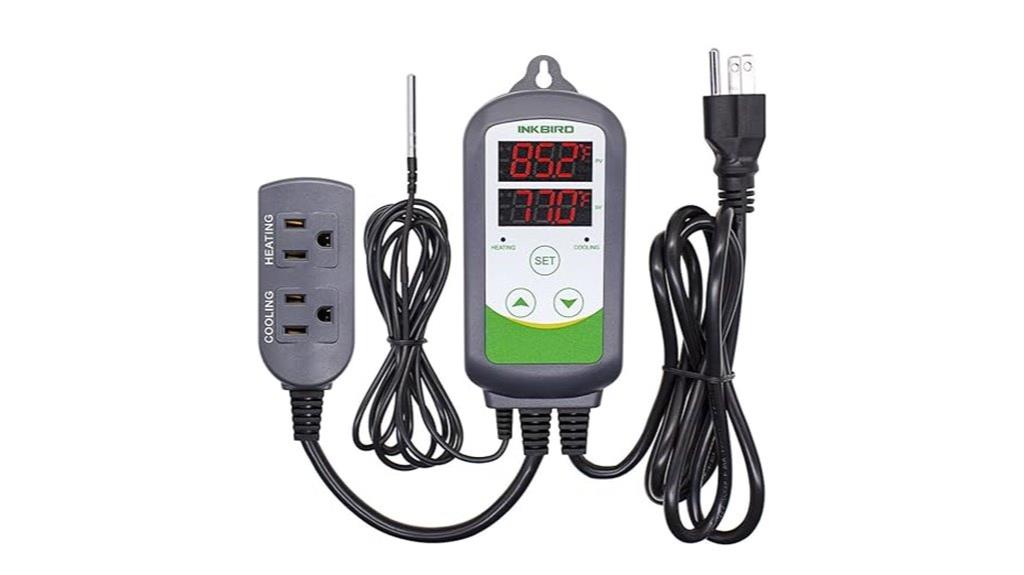
For those seeking precise temperature control in DIY projects or small-scale applications, the Inkbird ITC-308 Digital Temperature Controller offers a straightforward, plug-and-play design that’s easy to set up and use. It supports both Celsius and Fahrenheit readings, making it versatile for various needs. Its dual relay outputs allow simultaneous control of heating and cooling devices, while the dual display windows provide real-time temperature monitoring and easy adjustments. With high and low-temperature alerts, including buzzer notifications, it ensures ideal environment management. Capable of handling up to 1100 W at 110 V, it’s ideal for homebrewing, fermenters, greenhouses, and terrariums.
Best For: DIY enthusiasts and small-scale growers seeking reliable, easy-to-use temperature control for homebrewing, fermenters, greenhouses, or terrariums.
Pros:
- Simple plug-and-play setup with user-friendly interface
- Supports both Celsius and Fahrenheit readings for versatile use
- Dual relay outputs allow simultaneous control of heating and cooling devices
Cons:
- Maximum load capacity of 1100 W may limit use with high-power appliances
- Limited to 110 V, which may require additional adapters in some regions
- No built-in Wi-Fi or remote monitoring features
Sensi Lite Smart Thermostat
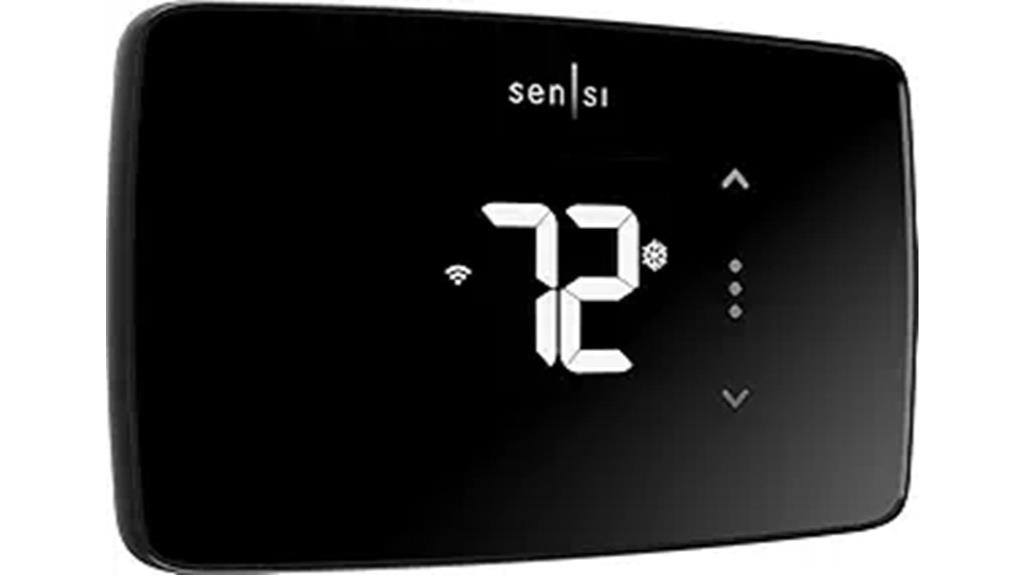
The Sensi Lite Smart Thermostat by Emerson stands out as an excellent choice for homeowners seeking an easy-to-install, energy-efficient device that doesn’t require extensive wiring. Its compact design fits seamlessly into most homes, offering Wi-Fi control through a user-friendly app that works with Alexa, Google Assistant, and SmartThings. With features like programmable schedules, auto changeover, and a filter indicator, it helps optimize your HVAC system and save energy—about 23%, according to Energy Star. Setup is straightforward with step-by-step instructions, and most systems don’t need a C-wire. Just keep in mind that heat pump and heat/cool systems may require specific wiring considerations.
Best For: homeowners looking for an easy-to-install, energy-efficient smart thermostat that works with most HVAC systems without requiring extensive wiring.
Pros:
- Simple DIY installation with clear instructions and minimal wiring requirements
- Compatible with popular voice assistants like Alexa, Google Assistant, and SmartThings
- Supports programmable schedules and energy-saving features, leading to about 23% HVAC energy savings
Cons:
- Wi-Fi connectivity issues may occur after power outages or battery replacements, requiring troubleshooting
- Not suitable for global use outside the US/Canada and may have limited functionality in some regions
- Some users report limited app features for detailed statistics and scheduling flexibility
Non-Programmable Digital Thermostat for Home

If simplicity and straightforward climate control top your list, a non-programmable digital thermostat might be your best choice. It offers easy-to-use push buttons, a large backlit LCD display, and simple wall mounting, making installation quick and hassle-free. Designed for single-stage systems like gas, oil, or electric furnaces, it doesn’t require a C-wire, supporting 24VAC power or batteries. Its intuitive controls allow you to manually set your preferred temperature without complicated schedules. Customers praise its reliability, ease of use, and clear display. Perfect for those who want basic, effective temperature management without the complexity of programmable models.
Best For: individuals seeking simple, reliable, and easy-to-use temperature control for single-stage heating and cooling systems without the need for programming or complex features.
Pros:
- Easy DIY installation with large terminal blocks and universal sub-base
- Large backlit LCD display and intuitive push button controls for effortless use
- Supports dual power options (24VAC or 2 AA batteries) without requiring a C-wire
Cons:
- Limited to single-stage systems; not suitable for multistage or heat pump setups
- Does not feature programmable schedules, which may be a drawback for advanced energy management
- Supports only 2 to 5 wires, making it incompatible with some wiring configurations and systems
Smart Thermostat with Room Sensor and Touchscreen
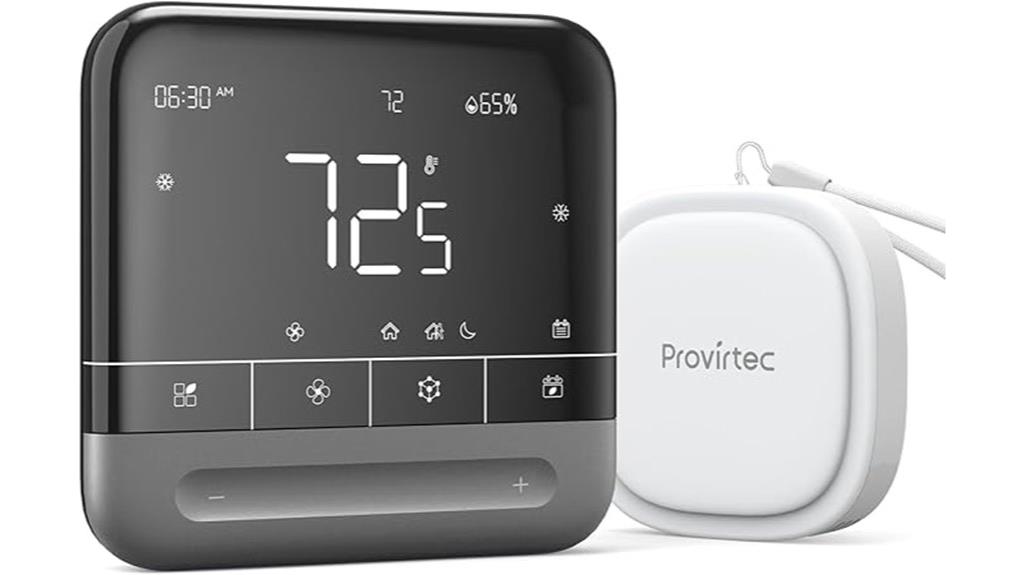
A smart thermostat with a room sensor and touchscreen is ideal for homeowners seeking precise climate control and user-friendly operation. It supports over 95% of 24VAC HVAC systems, including central air, heat pumps, boilers, and furnaces, but requires a C wire for installation. Its 7-day programmable schedule, Sleep/Home/Away modes, and real-time environment tracking via Provirtec thermo-hygrometer help optimize comfort and energy savings—up to 26% annually. The large 3.95-inch touchscreen offers clear visibility, while the traditional sliding touch design makes adjustments easy for everyone. Plus, WiFi and app control assure you can manage your home’s temperature remotely for maximum convenience.
Best For: homeowners seeking precise, customizable climate control with easy-to-use touchscreen and remote management capabilities.
Pros:
- Supports over 95% of 24VAC HVAC systems, including central air, heat pumps, boilers, and furnaces.
- Features a large 3.95-inch touchscreen and traditional sliding touch design for user-friendly operation.
- Offers energy savings of up to 26% annually through programmable schedules and smart modes.
Cons:
- Requires a C wire for installation; incompatible with millivolt, 110VAC, 120VAC, or high-voltage systems.
- Does not support S terminals for indoor/outdoor sensors, limiting sensor options.
- Firmware updates and pairing with thermo-hygrometer depend on a stable WiFi connection.
Honeywell Wi-Fi Smart Color Thermostat
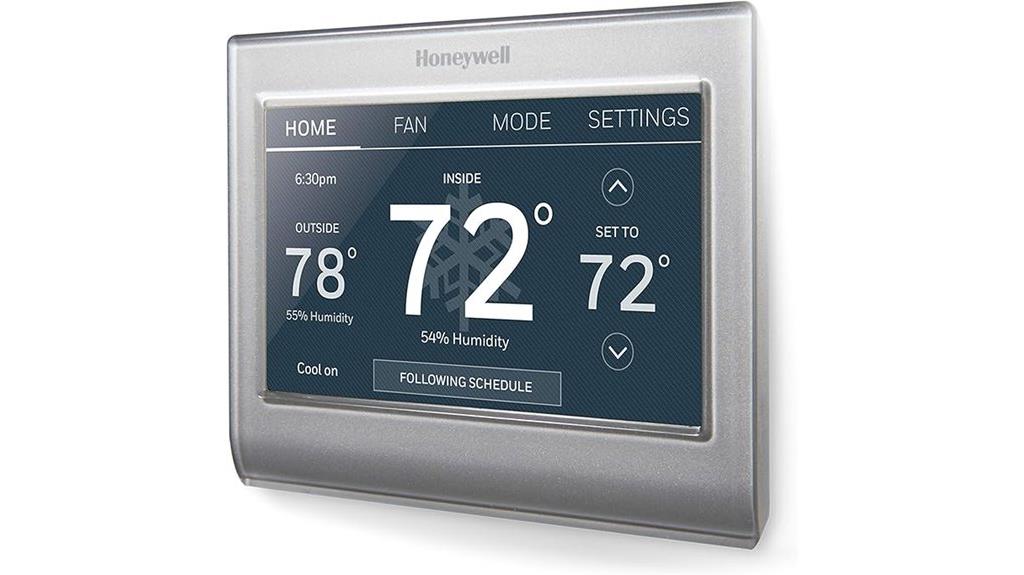
For homeowners seeking a visually appealing and highly customizable smart thermostat, the Honeywell Wi-Fi Smart Color Thermostat stands out with its full-color touchscreen display. It offers 7-day programmable scheduling, and its sleek design integrates seamlessly into modern homes. Compatible with Alexa, Google Home, SmartThings, and IFTTT, it allows remote control via Wi-Fi. The device shows indoor temperature, outdoor weather, humidity, and forecasts, giving extensive climate management. Easy to install for DIYers, it requires a C wire. Users praise its intuitive interface, responsive screen, and reliable connectivity, though some note fragile wiring connectors and limited fan control options.
Best For: homeowners seeking a customizable, visually appealing smart thermostat with comprehensive climate monitoring and easy DIY installation.
Pros:
- Intuitive full-color touchscreen interface and sleek modern design
- Compatible with popular smart home platforms like Alexa, Google Home, SmartThings, and IFTTT
- Supports remote control via Wi-Fi, with detailed indoor and outdoor weather display
Cons:
- Fragile wire connectors may require careful handling during installation
- Limited fan control options (ON, AUTO, CIRCULATING)
- Some features or app functionalities may be region-specific, primarily optimized for the US market
Factors to Consider When Choosing a Smart Thermostat With Energy‑Saving Gamification
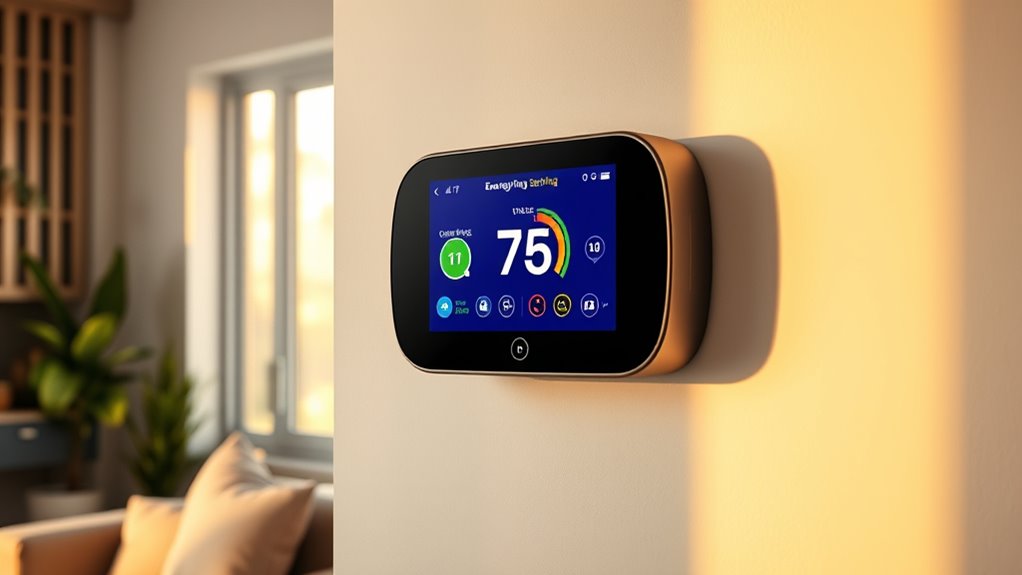
When choosing a smart thermostat with energy-saving gamification, I look at features that motivate me to save, like rewards or challenges. I also consider how much energy I can realistically save and whether the device integrates smoothly with my existing smart home setup. finally, I prioritize user-friendly design and easy installation to make the whole experience hassle-free.
Gamification Features
Gamification features in smart thermostats leverage points, badges, and leaderboards to motivate users to save energy and lower bills. These elements encourage consistent engagement by rewarding energy-saving behaviors and offering challenges or goals. Real-time feedback and progress tracking help users visualize their energy savings over time, making the impact of their actions clear. Incorporating game-like elements increases user interaction and promotes long-term habits of efficient thermostat management. Studies show that gamified energy-saving tools can boost participation by up to 15%, making it easier to stay motivated. When choosing a thermostat with these features, look for intuitive interfaces, customizable challenges, and social elements that foster friendly competition. These features turn energy conservation into an engaging, rewarding experience that can notably boost your savings.
Energy Savings Potential
Wondering how to maximize your energy savings with a smart thermostat? These devices can cut your heating and cooling costs by up to 26% annually through intelligent scheduling and automation. Gamification features, like rewards and challenges, motivate you to stick with energy-efficient habits, making conservation feel more engaging. Advanced learning algorithms adapt over time, automatically fine-tuning temperature settings based on your routines to save energy without sacrificing comfort. Plus, remote control capabilities let you adjust settings on the go, preventing unnecessary energy use when you’re away. Visual feedback, progress tracking, and incentives keep you motivated to maintain efficient habits. When choosing a smart thermostat, consider how effectively it can leverage these features to unlock maximum energy savings for your home.
Compatibility and Integration
Choosing a smart thermostat with energy-saving features isn’t just about its capabilities; compatibility and integration play a crucial role in making sure it works seamlessly with your existing home systems. First, verify it’s compatible with your HVAC type—gas, electric, oil, heat pump, or radiant—to ensure proper functionality. Next, check if it integrates smoothly with your smart home ecosystem, like Alexa, Google Assistant, Apple HomeKit, or SmartThings, for unified control. Make sure it supports reliable connectivity protocols such as Wi-Fi, Matter, or Bluetooth for remote access and automation. Also, confirm if your home’s wiring is compatible, especially if a C-wire is needed for continuous power. Lastly, look for multi-platform options like mobile apps and voice commands to maximize convenience and control.
Ease of Installation
Installing a smart thermostat with energy-saving gamification features can be straightforward, especially if you select a model designed for easy setup. Many models come with DIY installation guides that walk you through each step, making it accessible even if you’re not tech-savvy. Compatibility with existing HVAC wiring, particularly C wires, simplifies the process and helps avoid power issues. Some thermostats support wireless or battery-powered operation, which reduces wiring complexity and may eliminate the need for professional installation. Clear labeling of wires and included mounting hardware also make setup error-free and quick. Most user-friendly thermostats can be installed within 30 minutes to an hour by following the manufacturer’s instructions, saving you time and effort while getting your energy-saving gamification features up and running smoothly.
User Interface Design
A user-friendly interface makes operating a smart thermostat much simpler and more efficient. I look for large displays with clear controls that reduce setup time and make daily interactions effortless. Visual elements like touchscreens, icons, and color coding help me navigate quickly and access key functions without frustration. Customizable display options, such as showing the weather or clock, let me personalize the interface for better integration into my home. Automatic brightness adjustment guarantees good readability in different lighting conditions, while manual controls give me flexibility when needed. A well-designed interface minimizes errors and supports seamless interaction with energy-saving features and gamification elements, making it easier to stay engaged and optimize my energy use without hassle.
Support and Updates
Since smart thermostats rely heavily on firmware and software updates to stay secure and compatible with other devices, I prioritize models that receive regular support. Regular updates ensure the thermostat functions efficiently, remains secure from vulnerabilities, and stays compatible with evolving smart home ecosystems. Support services like customer assistance and troubleshooting are essential for resolving setup issues and maximizing energy-saving features. Ongoing updates often enhance gamification features, adding new challenges, rewards, or engagement tools to keep users motivated. A reliable support system with accessible updates helps maintain the effectiveness and user-friendliness of the energy-saving features over time. In short, strong support and consistent updates are crucial for a seamless, secure, and engaging smart thermostat experience.
Frequently Asked Questions
How Do Energy-Saving Gamification Features Motivate Long-Term Thermostat Use?
Energy-saving gamification features motivate me to stick with my thermostat because they turn saving energy into a fun challenge. I love earning points, reaching levels, or gaining rewards for adjusting my settings wisely. These game-like elements make me more aware of my energy habits, encouraging long-term use. They create a sense of achievement that keeps me engaged, helping me save money while enjoying the process.
Are There Any Hidden Costs Associated With Smart Thermostat Upgrades?
Oh, the hidden costs of upgrading to a smart thermostat? Sure, you might think it’s just a simple switch, but there’s always that sneaky expense—professional installation, compatible wiring, or even a new Wi-Fi setup. Don’t forget ongoing costs like app subscriptions or replacement parts down the line. It’s like buying a sleek new gadget—looks great, but beware of the hidden fees lurking around the corner.
Can These Thermostats Integrate With Existing Home Automation Systems?
When I look into smart thermostats, I find they generally integrate well with existing home automation systems like Alexa, Google Home, or Apple HomeKit. Most models are designed to be compatible, making setup straightforward. However, I always check specific compatibility details before buying, because some older systems or unique setups might need extra hubs or adapters. Overall, seamless integration is common, and it really enhances home automation convenience.
What Is the Typical Lifespan of a Smart Thermostat’S Batteries or Components?
You’re wondering about the lifespan of smart thermostat batteries or components. Typically, batteries last 1-3 years, depending on usage and model. Many thermostats have built-in rechargeable batteries or are hardwired, reducing the need for replacement. The main components, like sensors and control boards, often last 5-10 years with proper maintenance. Regular updates and careful handling can extend your thermostat’s lifespan, ensuring you’re always saving energy efficiently.
How Secure Is My Data When Using Energy-Saving Gamification Apps?
Think of your data as precious treasure; when using energy-saving gamification apps, security is paramount. I trust reputable brands that employ robust encryption and frequent updates to protect my info. While no system is entirely foolproof, these apps are designed to guard your privacy fiercely. Always stay vigilant—use strong passwords and keep software current. Your data’s security depends on both the app’s safeguards and your mindful habits.
Conclusion
Choosing the right smart thermostat is like finding the perfect key to release your home’s energy savings. With options packed with gamification features, you can turn saving energy into a fun challenge rather than a chore. Remember, the best thermostat isn’t just about tech—it’s about making your home smarter and your wallet happier. So go ahead, pick one that feels just right, and watch your savings grow like a well-tended garden.
